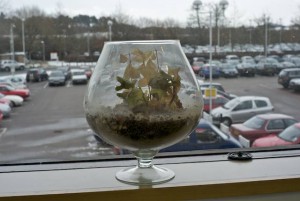… in brandy glasses.
Cambridge University – the Unauthorised History
Cambridge University is celebrating its 800th Anniversary this year. There are various ways of viewing its contributions to society. You could see it — as the university’s leading security expert Ross Anderson does — as 800 years of creative destruction.
If you want physical objects destroyed, the army can do that. As for badly-run companies, they get trashed when the economy goes into recession; the economist Joseph Schumpeter taught us that this ‘creative destruction’ is vital for progress as it clears away the deadwood and creates space in which new businesses can grow. And it’s just the same in ecosystems: from 1911, the USA put a lot of effort into stopping forest fires, but then discovered that although they saved individual plants and animals they were destroying the environment. A forest with a fire brigade is a sad old forest; a lot of plants from sequoias to proteas reproduce only in the aftermath of a fire.
Just as fire regenerates the forest, so a great university regenerates human culture – our view of the world and our understanding of it. We incinerate the rubbish. And Cambridge has long been the hottest flamethrower; we’re the most creatively destructive institution in all of human history. And big new things come from that. The ground we cleared made us the cradle of evangelical Christianity in the sixteenth and seventeenth centuries, of science in the seventeenth and eighteenth, of atheism in the nineteenth, and of all sorts of cool new stuff since – including the emerging sciences of life and information…
Read on.
Remembering Updike
Some lovely pieces by his New Yorker colleagues in the current issue. For example, this by his editor, Roger Angell.
As a contributor, he was patient with editing, and pertinaciously involved with his product: an editor’s dream. My end of the work was to point out an occasional inconsistent or extraneous sentence, or a passage that wanted something more. Almost under his breath over our phone connection, while we looked at the same lines, he would try out an alternative: “Which one sounds better, do you think?” Sighing, he would take us back over the same few words again and again, then propose or listen to a switch of some sort, and try again. All writers do this, but not many with such a lavishly extended consideration. He wanted to see each galley, each tiny change, right down to the late-closing page proofs, which he often managed to return by overnight mail an hour or so before closing, with new sentences or passages, handwritten in the margins in a soft pencil, that were fresher and more inventive and revealing than what had been there before. You watched him write.
This process sounds old-fashioned, but Updike was probably the very first New Yorker writer to shift over to a computer, back in the early eighties. “I don’t know how this will change my writing,” he wrote to me in advance, “but it will.” He was right, of course: the flavor was mysteriously different, the same wine but of another year.
And then this from Adam Gopnik:
It was part of the great good luck of this magazine that he needed, or indulged, us, and that his appetites and ambitions matched the dreams of the editors—which is only to say that several generations of editors tossed a bit less fitfully at 3 A.M., knowing that, if a book on some knotty modern subject had been sent out to Massachusetts, two weeks later there was sure to be, rebounding back, nine or ten pages of perfectly tuned prose—typo-free, full of cunning synopsis, serene judgment, big news (a generation got educated on Borges and Nabokov alongside him), bite without tooth marks, and always at the end a permanent turn of phrase or a metaphor, not a witticism merely but a benediction, a blessing, an insight that lifted it far above mere reviewing and into a form of witty personal poetry.
And, as those same generations of editors learned, the near-perfect thing was usually prefaced by a letter gaily outlining its supposed inadequacies, and all the reasons the editors might wisely prefer not to run it at all—a form of modesty that, given not just the quality but the heat and shimmer of what was enclosed, passed the edge of modesty to touch the edge of superstition: it was, one realized, Updike’s way of staying young, an outsider, pressing his face against a window, still the long-faced brilliant boy on a remote Pennsylvania farm turning the pages of a New York magazine and quietly deciding to be a cartoonist and a humorist and a parodist, while the loving and ambitious mother fretted and the weak but honest father listened to the radio (a family triangle that he inserted, again and again, into all our imaginations). He was still a kid from Shillington dreaming of being a New York wit, and feeling lucky that he had been allowed in at all.
What Obama’s victory meant to me
Extraordinary post by Chris Sacca. Thanks to Robert Scoble for the pointer.
Keep off the snow
Quote of the day
“I’ve got to own up to my mistake, which is that ultimately it’s important for this administration to send a message that there aren’t two sets of rules. You know, one for prominent people and one for ordinary folks who have to pay their taxes.”
President Obama, commenting on his mistake in running Tom Daschle for a post in his Administration.
Wow! When was the last time you heard a prominent politician saying something like that — and meaning it?
Journalists as windsocks
Andrew Currah has written a thoughtful piece in the Guardian based on his report, What’s Happening to Our News? which he wrote as a Visiting Fellow at the Reuters Institute in Oxford.
As more news consumers migrate online, the clickstream is likely to assume an even more important role. In the future, it has the capacity to not only transform the nature and breadth of the news agenda – but also to redefine well-established values.
In an effort to boost hits and advertising, publishers are already in danger of diluting their brand by allowing it to become the digital equivalent of a windsock – given shape by the prevailing direction of the clickstream rather than by a core of long-term editorial values.
The basic logic of a webcentric strategy is to maximise the size of the audience around the news, for as long as possible. But a rush to generate clicks may in fact erode the distinctiveness of the brand and its connection to a specific audience. By anchoring their brand identities in softer content, news publishers risk losing traffic to specialised sites that provide showbusiness and sports news more effectively – and also to advertisers who are increasingly demanding engaged, rather than transitory, eyeballs.
So what should news publishers be doing? A more viable strategy may be for them to identify and follow ‘editorial isolines’ – points of consistent editorial judgment that would establish them as digital "anchors", rather than digital windsocks. In practice, that would entail a strategic focus on certain kinds of coverage, and audiences reflecting existing editorial and brand values.
The report (available as a pdf download) is worth reading in full.
Job Loss in the Age of Blogs and Twitter
Interesting WSJ.com piece.
Internet games, gambling and other forms of online entertainment have seen significant surges in use in the several months since the economic downturn deepened. Social-networking services like Facebook, blogs and discussion forums — all well-known time sinks even during good times — are also seeing strong growth. Some purveyors of online entertainment say business has never been so good for them.
Robert Kraut, a professor of social psychology and human computer interaction at Carnegie Mellon University in Pittsburgh, says games and other forms of entertainment can provide escape for people steeped in anxieties about the economy. “There’s evidence these distractions have a psychological benefit because they prevent a downward spiral of rumination,” says Dr. Kraut.




